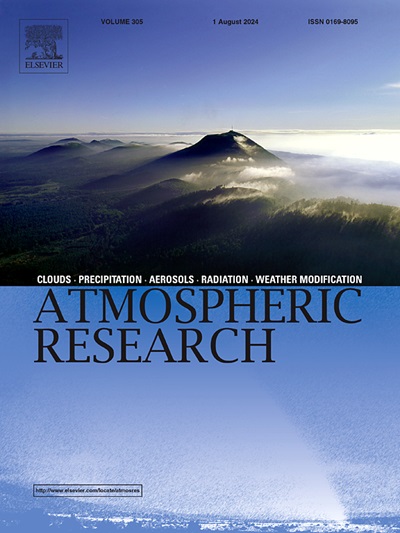Enhanced interannual variability of the May North Atlantic Oscillation and its impact on summer sea ice in the North Atlantic after the mid-2000s
IF 4.5
2区 地球科学
Q1 METEOROLOGY & ATMOSPHERIC SCIENCES
引用次数: 0
Abstract
Based on data diagnosis and numerical experiments, this study investigated the changes in the interannual properties of the May North Atlantic Oscillation (NAO) and their impact on summer (June–July) sea ice in the North Atlantic during 1979–2021. Results showed statistically significant increase in the interannual variability of the May NAO after the mid-2000s, which had remarkably enhanced impact on summer sea ice in the eastern Hudson Bay (EHB) and the western Labrador Sea (WLS). During 2005–2021, corresponding to a positive phase of the May NAO, anomalous surface westerly or northwesterly winds prevailed over the Hudson Bay and Labrador Sea in May. This led to statistically significant increase in sea ice in both the EHB and the WLS in May via dynamic processes (favoring southeastward movement of the sea ice) and thermal processes (changing surface turbulent heating and shortwave radiation). In comparison with the situation in May, the increase in sea ice in the EHB developed further during summer mainly via thermal processes (positive feedback between the increased sea ice and shortwave radiation). In contrast, amplitude of the increased sea ice in the WLS was comparable between May and summer. Dynamic processes (southeastward movement of sea ice), which was induced by a barotropic anomalous high in the troposphere centered over the Labrador Peninsula, favored the increase in sea ice in summer in the WLS. The tripole sea surface temperature anomalies in the North Atlantic and increased snowpack on the Labrador Peninsula in May, triggered by the positive phase of the May NAO, played an important role in the formation of the anomalous high. During 1979–2004, the surface wind, snowpack, and tripole sea surface temperature anomalies in May, triggered by the May NAO, were relatively weak, leading to statistically insignificant changes in summer sea ice in the EHB and WLS.
2000 年代中期以后北大西洋五月涛动的年际变率增强及其对北大西洋夏季海冰的影响
本研究基于数据诊断和数值实验,研究了1979-2021年期间北大西洋5月涛动(NAO)的年际特性变化及其对北大西洋夏季(6-7月)海冰的影响。结果表明,2000 年代中期以后,5 月北大西洋涛动的年际变率在统计上明显增加,对哈德逊湾东部和拉布拉多海西部夏季海冰的影响显著增强。在 2005-2021 年期间,与 5 月 NAO 正相位相对应,哈得逊湾和拉布拉多海 5 月份盛行异常的表面西风或西北风。通过动力过程(有利于海冰向东南移动)和热力过程(改变表面湍流加热和短波辐射),这导致 EHB 和 WLS 的海冰在 5 月份出现统计意义上的显著增加。与五月份的情况相比,夏季 EHB 海冰的增加主要通过热过程(增加的海冰与短波辐射之间的正反馈)进一步发展。与此相反,5 月和夏季,WLS 海冰增加的幅度相当。以拉布拉多半岛为中心的对流层气压各向异性异常高气压诱发的动力过程(海冰向东南移动)有利于夏季西低海区海冰的增加。北大西洋的三极海面温度异常和拉布拉多半岛 5 月份积雪的增加(由 5 月份北大西洋环流正相位引发)在异常高点的形成过程中发挥了重要作用。在1979-2004年期间,5月NAO引发的表面风、积雪和5月三极海面温度异常相对较弱,导致EHB和WLS夏季海冰的变化在统计上不显著。
本文章由计算机程序翻译,如有差异,请以英文原文为准。
求助全文
约1分钟内获得全文
求助全文
来源期刊

Atmospheric Research
地学-气象与大气科学
CiteScore
9.40
自引率
10.90%
发文量
460
审稿时长
47 days
期刊介绍:
The journal publishes scientific papers (research papers, review articles, letters and notes) dealing with the part of the atmosphere where meteorological events occur. Attention is given to all processes extending from the earth surface to the tropopause, but special emphasis continues to be devoted to the physics of clouds, mesoscale meteorology and air pollution, i.e. atmospheric aerosols; microphysical processes; cloud dynamics and thermodynamics; numerical simulation, climatology, climate change and weather modification.
 求助内容:
求助内容: 应助结果提醒方式:
应助结果提醒方式:


